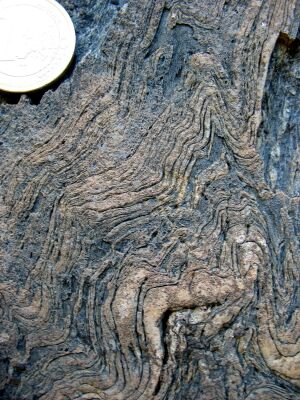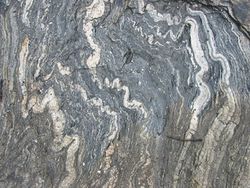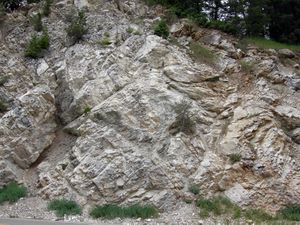صخور متحولة
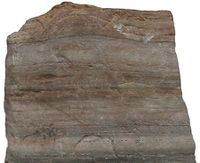
الصخور المتحولة، تنشأ من الصخور النارية أو الصخور الرسوبية التى كانت موجودة من قبل تحت تأثير الحرارة والضغط والمحاليل الكيميائية النشطة. ويحدث هذا التحول عندما تتغير الظروف الطبيعية و الكيميائية التى تتعرض لها الصخور مما يجعل كثيرا من المعادن المكونة للصخر غير ثابتة للظروف الجديدة و بالتالى تتحول إلى معادن جديدة أكثر ملائمة للبيئة الجديدة.
التسمية
أن قشرة الأرض تتعرض لعوامل غامضة من الضغط, أو الحرارة أو كليهما معاً. وكثيراً ما تعمل هذه العوامل على تغيير المعالم الأصلية للصخور نارية كانت أم رسوبية, وقد سميت الصخور التي تتعرض للتغير من جراء الضغط والحرارة بالصخور المتحولة.
سبب تغير الصخور
قد يحدث التغيير في طبيعة الصخور نتيجة تعرضها للتشقق والتفلق, فقد تتعرض الصخور الجيرية مثلاً لهذه الظاهرة مما يؤدي إلى تحولها إلى أنواع متعددة الأشكال والألوان هي التي تعرف من الناحية التجارية بالرخام. ويرجع سبب تعدد أنواعها إلى تسرب محاليل سليكية مختلفة في خصائصها تملأ شروخ هذه الصخور ومفاصلها, ولكن كلمة رخام نادراً ما يطلقها الجيولوجيون على الصخور الجيرية التي تتحول بالطريقة السابقة, إذ إن الرخام في نظرهم هو الصخر الجيري الذي أعيد تبلوره بفعل الضغط والحرارة. أما الضغط فمصدره في الغالب تلك الطبقات البالغة السمك التي قد تعلو الطبقة الجيرية, وأما مصدر الحرارة فهو تلك الإندفاعات النارية التي تؤدي إلى تحويل مادة كربونات الكالسيوم - التي تمثل المادى الرئيسية التي تدخل في تكوين الصخور الجيرية - إلى بلورات ملتحمة من الكالسايت تتشابه تشابهاً كبيراً في أحجامها. وكثيراً ما تؤدي عملية التحول هذه إلى إزالة كلأثر للحفريات التي يتألف منها الصخر الجيري.
المعادن المتحولة
تتم عملية تحول المعادن بينما تبقى الصخور في الحالة الصلبة و كثيرا ما تكتسب الصخور المتحولة أنسجة و تراكيب جديدة تختلف عن نسيج الصخور الأصلية تمام الإختلاف. و نتيجة لفعل الضغوط القاصة التى يتعرض لها الصخر فإن الحبيبات المعدنية قد تتهشم أو تتفلطح أو تترتب في طبقات شبه متوازية على هيئة ترتيب شرائطى مميز للصخور المتحولة.
قوام الصخور المتحولة
أنواع التحولات
التحول التماسي أو الحراري
يحدث التحول الإلتماسي Contact Metamphorism عندما تندفع صخور نارية تحرق ما حولها من صخور تماماً كما يحرق الطين ليصير فخاراً. ويؤدي حرق الصخور المجاورة للإندفاعات النارية إلى تغير في طبيعتها كما يؤدي إلى إعادة تبلورها, وهذا ما يحدث عند تحول الكوارتز إلى صخر الكوراتزيت.
ويحدث للصخور الواقعة حول منطقة تداخلت فيها تكوينات نارية إذ تتحول طبيعتها نتيجة إرتفاع درجة الحرارة, فتحترق, كما تتغير خصائصها وتتعدل أيضاً نتيجة تسرب بعض المواد المنصهرة والمياه المرتفعة في درجة حرارتها, والتي عادة ما تصاحب الإندفاعات النارية, وتعرف المنطقة الواقعة حول صخور متداخلة - بحيث أدى تداخلها إلى أن تتحول طبيعة صخورها - بالهالة المتحولة وتتحول صخور الهالة في معظم الحالات نتيجة الحرارة والإحتكاك إلى صخور نارية صلبة تدخل ضمن مجموعة كبيرة من الصخور هي التي تعرف بمجموعة الصخور الرنانة.
وقد يحدث التحول بالسوائل الثلاث السابقة على نطاق واسع وتتأثر به منطقة كبيرة من قشرة الأرض, وتعرف التحول الذي يحدث في هذه الحالة بالتحول الإقليمي
تتسبب المتدخلات النارية في تعرض الصخور المحيطة بها مباشرة إلي ظروف جديدة من الحرارة والضغط مما يؤدي إلي تحول الصخر الأصلي. ويعرف هذا النوع من التحول المحلى بالتحول التماسي، كما يسمى أحيانا بالتحول الحراري. ويؤثر هذا النوع من التحول عادة على منطقة رقيقة فقط من الصخور المحيطة، على امتداد أسطح التلامس مع المتداخلات النارية. ويرجع التحول المعدني في العديد من الصخور المتحولة بالتماس، وخاصة عند المتداخلات القريبة من السطح إلي درجة حرارة الصهارة المرتفعة، ويكون تأثير الضغط مهما عندما تتداخل الصهارة على أعماق كبيرة. ويكون التحول التماسي الناشيء عن الصخور البركانية محدودا، حيث تتكون في هذه الحالات نطاقات رقيقة جدا بسبب تبرد اللابة بسرعة عند السطح، ولا يوجد ما يكفي من الوقت لتؤثر حرارة اللابة على الأجزاء العميقة من الصخور المحيطة.
ويسمى نطاق الصخر في المنطقة المحيطة بالمتداخل الناري. والذي تظهر به آثار التحول باسم هالة التحول ، ويعتمد سمك هالة التحول على حجم الجسم المتداخل ودرجة حرارته، وعلى كمية الماء في الصخور المتحولة.ففي المتداخلات الصغيرة، مثل: الجدد الموازية أو القواطع والتي يبلغ سمكها عدة أمتار قليلة، وفي غياب السوائل، فإن نطاق التحول يكون فقط عدة سنتيمترات سمكا (شكل 8- 4). ويكون الصخر المتحول صلبا ودقيق التحبب ومكونا من كتلة من الحبيبات المتداخلة المتساوية الحجم. ويحتوي المتداخل الناري الكبير الحجم على طاقة حرارية أكبر من تلك الموجودة في المتدخلات الصغيرة، كما يخرج منه الكثير من بخار الماء. وعندما يبلغ قطر المتداخل الناري كيلومترا أو أكثر، فقد يصل عرض هالة التحول عدة مئات من الأمتار أو أكثر، وتميل الصخور المتحولة لأن تكون خشنة التحبب (شكل 8 – 5).
وفي داخل نطاقات التحول الكبيرة والتي تخللتها السوائل الحارة، فإنه يمكن تعرف نطاقات عديدة متحدة المركز تقريبا مكونة من تجمعات معدنية، يتميز كل نطاق منها بمدى معين من درجة الحرارة (شكل 8 – 5). حيث تكون درجات الحرارة عالية بجوار الجسم الناري مباشرة، وتتكون معادن لامائية مثل: الجارنت والبيروكسين، بينما توجد المعادن المائية مثل: الابيدوت والأمفيبول، ثم معادن: الميكا والكلوريت في النطاقات الخارجية البعيدة عن الجسم الناري.
وتعتمد مجموعة المعادن الموجودة في كل نطاق على التركيب المعدني للصخر الذي يتداخل فيه الجسم الناري وعلى السائل المنبثق من الجسم الناري، علاوة على درجة الحرارة والضغط. ويتواجد التحول التماسي على امتداد الألواح المتقاربة والنقاط الساخنة المحيطة والقارية، حيث يتواجد النشاط الناري الذي يرتبط به التحول. وحيث إن النشاط الناري يتواجد أيضا في التحول الإقليمي، لذلك يوجد التحول التماسي أيضا في أحزمة الجبال المشوهة.
التحول النطاقي أو الديناميكي
التحول النطاقي Regional Metamorphism وفي يحدث أن تتوسط طبقة من صخر لين كالصخر الطيني أو الصلصال طبقتين من صخر أكثر صلابة كالحجر الجيري مثلاً. وتعرف في هذه الحالة طبقة الصخر اللين بالطبقة غير المتكافئة بينما تعرف طبقات الصخر الجيري الصلدة بالطبقات المتكافئة . وإذا ما تعرضت المنطقة التى توجد بها هذه الصخور لحركة ضاغطة شديدة في قشرة الأرض تسببها ضغوط جانبية, فالذي يحدث هو تعرض الصخور المتكافئة الصلبة للإلتواء, أما طبقة الطين اللينة فتنثني إزاء هذه الضغوط ثنيات صغيرة لا تتجاوز بضعة سنتيمترات ممدودة في بعض الأحيان, وتسير عمودية على الإتجاه الذي حدث منه الضغط, وفي خلال هذه العملية يتحول الصخر الطيني إلى ما يعرف بالإردواز.
يعتبر التحول الإقليمي، أكثر أنواع التحول انتشاراً، حيث تؤثر كل من درجة الحرارة المرتفعة والضغط العالي على أحزمة أو مساحات شاسعة من القشرة الأرضية تصل إلي عشرات الآلاف من الكيلومترات المربعة. وتتغير درجات الحرارة أثناء التحول الإقليمي بدرجة كبيرة. فهي تتراوح بين 300 و800م (الحد الأقصى للتحول نحو 900م)، في حين يتراوح الضغط بين 2 و6 كيلوبار أو أكثر. ويستخدم هذا المصطلح لتمييز هذا النوع من التحول عن التغيرات المحلية الأخرى، والتي تحدث بالقرب من المتداخلات النارية أو الصدوع. ويحطم التحول الإقليمي بعض أو كل الأنسجة الأصلية للصخور النارية أو الرسوبية، حيث يؤدي إلي تكون معادن وأنسجة جديدة. وهناك ثلاثة مواضع تكتونية يتم فيها التحول الإقليمي:
- الأقواس البركانية حيث تنشأ بعض أحزمة التحول الإقليمي نتيجة اندساس الألواح المحيطية بعمق في الوشاح والتسخين بالصهارة الصاعدة (شكل 8 – 3).
- الخنادق المحيطية، حيث تتكون الأحزمة الأخرى نتيجة الضغط العالي والحرارة المنخفضة نسبيا بالقرب منها، ويسبب الاندساس سحب القشرة المحيطية الباردة نسبيا إلي أسفل.
- حدود الألواح القارية المتقاربة (المتصادمة)، حيث يحدث التحول الإقليمي تحت ضغوط ودرجات حرارة عالية جدا في المستويات الأعمق من القشرة، ويتشوه الصخر وتتكون أحزمة جبال مرتفعة.
التحول التهشمي
يتحول الصخر المطحون إلي كتلة كالعجين، حيث قد يحدث التحول على امتداد الصدوع، وتسبب الحركات التكتونية تكسر القشرة الأرضية وانزلاقها، ممايؤدي إلي تكسر الصخر الصلب وطحنه على امتداد سطح الصدع، ويتكون نسيج مكسر ومطحون (شكل 8 – 6). وقد يتحول الصخر المطحون إلي كتلة كالعجين، وهذا هو التحول التهشمي. ويسمى التحول التهشمي أحيانا باسم التحول الديناميكي ( التحول الحركي). فعندما يتعرض صخر خشن التحبب مثل الجرانيت إلي إجهادات متباينة شديدة، فإن حبيبات المعادن تتكسر وتطحن. ومع زيادة التحول التهشمي، فإن حبيبات المعادن تصبح مستطيلة.ويبدي الصخر نسيجا متورقا ويعرف باسم الميلونيت. ويحدث هذا التحول أساسا تحت ضغط مرتفع نتيجة طحن وجز الصخر أثناء الحركات التكتونية. لذلك تتواجد الصخور التهشمية غالبا مع الصخور المتحولة إقليميا في أحزمة الجبال المشوهة بشدة، حيث يكون التصدع ممتدا وشاملا.
التحول الحرمائي
هناك نوع آخر من التحول يسمى التحول الحرمائي يكون مصاحبا لحيود وسط المحيط، ويعرف التحول في هذه الحالة بتحول قاع المحيط. حيث تتباعد الألواح وتنتشر وتكون الصهارات البازلتية الصاعدة قشرة محيطية جديدة. حيث ويعمل البازليت الساخن على تسخين ماء البحر المتخلل في كسوره. وتحفز الزيادة في درجة الحرارة التفاعلات الكيميائية بين ماء البحر وصخر البازلت. ليتكون نوع من البازلت يختلف في تركيبه الكيميائي عن تركيب البازلت الأصلي، نتيجة إضافة عنصر الصوديوم وخروج عنصر الكالسيوم أساسا، يعرف بالسبيليت. ويحدث التحول الحرمائي أيضاً في القارات، حيث تحول السوائل الحرمائية الصاعدة من المتداخلات النارية كلاً من الصخور التي تعلوها وكذلك الصخور المدفونة في الأعماق، والتي تحولها إقليميا. وقد يحدث التحول الحرمائي في مناطق القشرة الأرضية المختلفة، والتي تتواجد بها محاليل حرمائية.
التحول بالدفن
من المعروف أن الصخور الرسوبية تدفن تدريجيا نتيجة هبوط القشرة الأرضية (الأحواض الرسوبية) والتراكم السميك للرواسب، فترتفع درجة حرارتها ببطء وتصبح في حالة اتزان مع درجات حرارة القشرة المحيطة بها. ويحدث بسبب هذه العملية تغيرات ما بعد الترسيب، والتي تشمل تغير التركيب المعدني والنسيج. وتتدرج عمليات ما بعد الترسيب إلي تحول بالدفن، وهو تحول منخفض الرتبة يحدث بسبب الحرارة والضغط الناشيء من حمل الرواسب والصخور الرسوبية المتراكمة.
الأوجه المتحولة Metamorphic facies
| قالب:Metamorphic facies to click |
| Figure 1. Diagram showing metamorphic facies in pressure-temperature space. The domain of the graph corresponds to conditions within the Earth's crust and upper mantle. |
A metamorphic facies is a set of distinctive assemblages of minerals that are found in metamorphic rock that formed under a specific combination of pressure and temperature. The particular assemblage is somewhat dependent on the composition of that protolith, so that (for example) the amphibolite facies of a marble will not be identical with the amphibolite facies of a pelite. However, the facies are defined such that metamorphic rock with as broad a range of compositions as is practical can be assigned to a particular facies. The present definition of metamorphic facies is largely based on the work of the Finnish geologist, Pentti Eskola, with refinements based on subsequent experimental work. Eskola drew upon the zonal schemes, based on index minerals, that were pioneered by the British geologist, George Barrow.[1]
The metamorphic facies is not usually considered when classifying metamorphic rock based on protolith, mineral mode, or texture. However, a few metamorphic facies produce rock of such distinctive character that the facies name is used for the rock when more precise classification is not possible. The chief examples are amphibolite and eclogite. The British Geological Survey strongly discourages the use of granulite as a classification for rock metamorphosed to the granulite facies. Instead, such rock will often be classified as a granofels.[2] However, this approach is not universally accepted.[3]
مناطق تواجد الصخور المتحولة
توجد أمثلة عديدة لمناطق واسعة تكثر بها الصخور المتحولة، ومن أمثلتها هضبة الحبشة، وشمال هضبة الدكن، ومقاطعة كولومبيا بأمريكا الشمالية، وبعض المناطق الجنوبية من هضبة البرازيل وجبال البحر الأحمر في الجمهورية العربية المتحدة.
Metamorphic rocks make up a large part of the Earth's crust and form 12% of the Earth's land surface.[4] The lower continental crust is mostly metamafic-rock and pelite which have reached the granulite facies. The middle continental crust is dominated by metamorphic rock that has reached the amphibolite facies.[5] Within the upper crust, which is the only part of the Earth's crust geologists can directly sample, metamorphic rock forms only from processes that can occur at shallow depth. These are contact (thermal) metamorphism, dynamic (cataclastic) metamorphism, hydrothermal metamorphism, and impact metamorphism. These processes are relatively local in occurrence and usually reach only the low-pressure facies, such as the hornfels and sanidinite facies. Most metamorphic rock is formed by regional metamorphism in the middle and lower crust, where the rock reaches the higher-pressure metamorphic facies. This rock is found at the surface only where extensive uplift and erosion has exhumed rock that was formerly much deeper in the crust.[6]
الأحزمة الجبلية
Metamorphic rock is extensively exposed in orogenic belts produced by the collision of tectonic plates at convergent boundaries. Here formerly deeply buried rock has been brought to the surface by uplift and erosion.[7] The metamorphic rock exposed in orogenic belts may have been metamorphosed simply by being at great depths below the Earth's surface, subjected to high temperatures and the great pressure caused by the immense weight of the rock layers above. This kind of regional metamorphism is known as burial metamorphism. This tends to produced low-grade metamorphic rock.[8] Much more common is metamorphic rock formed during the collision process itself.[9] The collision of plates causes high temperatures, pressures and deformation in the rocks along these belts.[10] Metamorphic rock formed in these settings tends to shown well-developed schistosity.[9]
Metamorphic rock of orogenic belts shows a variety of metamorphic facies. Where subduction is taking place, the basalt of the subducting slab is metamorphosed to high-pressure metamorphic facies. It initially undergoes low-grade metamorphism to metabasalt of the zeolite and prehnite-pumpellyite facies, but as the basalt subducts to greater depths, it is metamorphosed to the blueschist facies and then the eclogite facies. Metamorphism to the eclogite facies releases a great deal of water vapor from the rock, which drives volcanism in the overlying volcanic arc. Eclogite is also significantly denser than blueschist, which drives further subduction of the slab deep into the Earth's mantle. Metabasalt and blueschist may be preserved in blueschist metamorphic belts formed by collisions between continents. They may also be preserved by obduction onto the overriding plate as part of ophiolites.[11] Eclogites are occasionally found at sites of continental collision, where the subducted rock is rapidly brought back to the surface, before it can be converted to the granulite facies in the hot upper mantle. Many samples of eclogite are xenoliths brought to the surface by volcanic activity.[12]
Many orogenic belts contain higher-temperature, lower-pressure metamorphic belts. These may form through heating of the rock by ascending magmas of volcanic arcs, but on a regional scale. Deformation and crustal thickening in an orogenic belt may also produce these kinds of metamorphic rocks. These rocks reach the greenschist, amphibolite, or granulite facies and are the most common of metamorphic rocks produced by regional metamorphosis. The association of an outer high-pressure, low-temperature metamorphic zone with an inner zone of low-pressure, high-temperature metamorphic rocks is called a paired metamorphic belt. The main islands of Japan show three distinct paired metamorphic belts, corresponding to different episodes of subduction.[13][14]
Metamorphic core complexes
Metamorphic rock is also exposed in metamorphic core complexes, which form in region of crustal extension. They are characterized by low-angle faulting that exposes domes of middle or lower crust metamorphic rock. These were first recognized and studied in the Basin and Range Province of southwestern North America,[15] but are also found in southern Aegean Sea, in the D'Entrecasteaux Islands, and in other areas of extension.[16]
Granite-greenstone belts
Continental shields are regions of exposed ancient rock that make up the stable cores of continents. The rock exposed in the oldest regions of shields, which is of Archean age (over 2500 million years old), mostly belong to granite-greenstone belts. The greenstone belts contain metavolcanic and metasedimentary rock that has undergone a relatively mild grade of metamorphism, at temperatures of 350–500 °C (662–932 °F) and pressures of 200–500 MPa (2،000–5،000 bar). They can be divided into a lower group of metabasalts, including rare metakomatiites; a middle group of meta-intermediate-rock and meta-felsic-rock; and an upper group of metasedimentary rock.[17]
The greenstone belts are surrounded by high-grade gneiss terrains showing highly deformed low-pressure, high-temperature (over 500 °C (932 °F)) metamorphism to the amphibolite or granulite facies. These form most of the exposed rock in Archean cratons.[17]
The granite-greenstone belts are intruded by a distinctive group of granitic rocks called the tonalite-trondhjemite-granodiorite or TTG suite. These are the most voluminous rocks in the craton and may represent an important early phase in the formation of continental crust.[17]
Mid-ocean ridges
Mid-ocean ridges are where new oceanic crust is formed as tectonic plates move apart. Hydrothermal metamorphism is extensive here. This is characterized by metasomatism by hot fluids circulating through the rock. This produces metamorphic rock of the greenschist facies. The metamorphic rock, serpentinite, is particularly characteristic of these settings, and represents chemical transformation of olivine and pyroxene in ultramafic rock to serpentine group minerals.[18] [9]
Contact aureoles
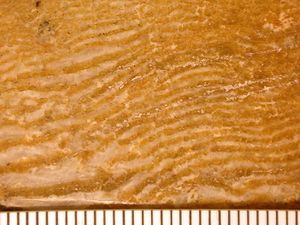
Contact metamorphism takes place when magma is injected into the surrounding solid rock (country rock).[9] The changes that occur are greatest wherever the magma comes into contact with the rock because the temperatures are highest at this boundary and decrease with distance from it. Around the igneous rock that forms from the cooling magma is a metamorphosed zone called a contact aureole. Aureoles may show all degrees of metamorphism from the contact area to unmetamorphosed (unchanged) country rock some distance away. The formation of important ore minerals may occur by the process of metasomatism at or near the contact zone.[19] Contact aureoles around large plutons may be as much as several kilometers wide.[20]
The term hornfels is often used by geologists to signify those fine grained, compact, non-foliated products of contact metamorphism.[21] The contact aureole typically shows little deformation, and so hornfels is usually devoid of schistosity and forms a tough, equigranular rock. If the rock was originally banded or foliated (as, for example, a laminated sandstone or a foliated calc-schist) this character may not be obliterated, and a banded hornfels is the product.[21] Contact metamorphism close to the surface produces distinctive low-pressure metamorphic minerals,[9] such as spinel, andalusite, vesuvianite, or wollastonite.[22]
Similar changes may be induced in shales by the burning of coal seams.[21] This produces a rock type named clinker.[23]
There is also a tendency for metasomatism between the igneous magma and sedimentary country rock, whereby the chemicals in each are exchanged or introduced into the other. In that case, hybrid rocks called skarn arise.[21][24]
التواجدات الأخرى
Dynamic (cataclastic) metamorphism takes place locally along faults. Here intense shearing of the rock typically forms mylonites. [9]
Impact metamorphism is unlike other forms of metamorphism in that it takes place during impact events by extraterrestrial bodies. It produces rare ultrahigh pressure metamorphic minerals, such as coesite and stishovite.[25] Coesite is rarely found in eclogite brought to the surface in kimberlite pipes, but the presence of stishovite is unique to impact structures.[26]
الاستخدامات
Slate tiles are used in construction, particularly as roof shingle.[27]
Quartzite is sufficiently hard and dense that it is difficult to quarry. However, some quartzite is used as dimension stone, often as slabs for flooring, walls, or stair steps. About 6% of crushed stone, used mostly for road aggregate, is quartzite.[28]
Marble is also prized for building construction[29] and as a medium for sculpture.[30]
المخاطر
Schistose bedrock can pose a challenge for civil engineering because of its pronounced planes of weakness.[31] A hazard may exist even in undisturbed terrain. On August 17, 1959, a magnitude 7.2 earthquake destabilized a mountain slope near Hebgen Lake, Montana, composed of schist. This caused a massive landslide that killed 26 people camping in the area.[32]
Metamorphosed ultramafic rock contains serpentine group minerals, which includes varieties of asbestos that pose a hazard to human health.[33]
أمثلة للصخور المتحولة
- الكوارتزيت أو المرويات.
- الرخام.
- الشيست.
- النيس.
تقسيم الصخور المتحولة
تنقسم الصخور المتحولة عامة إلى نوعين رئيسيين:
صخور النايس
هي صخور متحولة عن الجرانيت وتتركب من نفس المعادن التي يتكون منها, وقد نجم عن تحولها ظهور معادن الجرانيت على شكل صفائح رقيقة , وقد تبدو هذه الصفائح متموجة, وهي ملتحمة مع بعضها البعض إلتحاماًَ شديداً في معظم الحالات ولذا ينتمي صخر النايس بصفة عامة إلى فصيلة الصخور الرنانة الصلبة. والمهم هو أن التركيب المعدنمي للناس مماثل لتركيب صخر الجرانيت مما يدل على أصله الجرانيتي. وعلى أننا كثيراً ما نجد أنواعاً كثيرة من النايس بعضها مشتق من أصل ناري, وبعضها ألآخر ذو أصل رسوبي.
صخور الشست
تظهر هي الأخرى على شكل صفائح ملتحمة ببعضها البعض والفرق الرئيسي بينها وبين صخور النايس هو أن الأخيرة لا تتميز بتشابهها, إذ قد تظهر بينها حبيبات بعض المعادن, أما صخور الشست فصفائحها متشابهة, كما أن وجود بعض المعادن (كالميكا والكلورايت والتلك وبعض أنواع من الهورنبلند) التي تظهر اصلاً على شكل صفائح رقيقة (قابلة للسحب) يعتبر عاملأً رئيسياً في تكون صخور الشست. ومن أمثلة صخور الشست: شست الميكا وشست الأوجيت, وتظهر فيه ظاهرة الطابقية "الصفائحية" ولكنا تقتصر على معدن الأوجيت, وذلك عندما يتعرض صخر البازلت للتحول.
ولهذا نجد أن أنواع صخور الشست تختلف إختلافاً كبيراً بإختلاف التركيب المعدني الأصلي للصخر قبل تحوله, كما لابد أن تختلف كذلك بإختلاف درجة الحرارة، ودرجة الضغط, التي تسبب التحول. وقد أثبت العلماء أن هناك أنواعاً من المعادن لا يمكن أن توجد إلا في الصخور المتحركة دون الصخور النارية أو الرسوبية, وكل معدن من هذه المعادن له القدرة على التحول تحت ظروف معينة من الضغط والحرارة. [34]
انظر أيضاً
وصلات خارجية
- Metamorphic textures - Middle East Technical University
- Metamorphism - U. of Alabama
- Types of metamorphism - Tulane U.
- Contact metamorphism example
المصادر
- ^ Yardley 1989, pp. 49-51.
- ^ خطأ استشهاد: وسم
<ref>غير صحيح؛ لا نص تم توفيره للمراجع المسماةBGS - ^ خطأ استشهاد: وسم
<ref>غير صحيح؛ لا نص تم توفيره للمراجع المسماةschid-etal=2007 - ^ خطأ استشهاد: وسم
<ref>غير صحيح؛ لا نص تم توفيره للمراجع المسماةWilkinson2008 - ^ Rudnick, Roberta L.; Fountain, David M. (1995). "Nature and composition of the continental crust: A lower crustal perspective". Reviews of Geophysics. 33 (3): 267. Bibcode:1995RvGeo..33..267R. doi:10.1029/95RG01302.
- ^ Yardley 1989, pp. 12-13.
- ^ Levin 2010, pp. 76-77, 82-83.
- ^ Robinson, D.; Bevins, R. E.; Aguirre, L.; Vergara, M. (1 January 2004). "A reappraisal of episodic burial metamorphism in the Andes of central Chile". Contributions to Mineralogy and Petrology. 146 (4): 513–528. Bibcode:2004CoMP..146..513R. doi:10.1007/s00410-003-0516-4. S2CID 140567746.
- ^ أ ب ت ث ج ح Yardley 1989, p. 12.
- ^ Kearey, P.; Klepeis, Keith A.; Vine, Frederick J. (2009). Global tectonics (3rd ed.). Oxford: Wiley-Blackwell. pp. 275–279. ISBN 9781405107778.
- ^ Kearey, Klepeis & Vine 2009, pp. 275-279.
- ^ Kearey, Klepeis & Vine 2009, pp. 367-368.
- ^ Miyashiro, Akiho (1973). Metamorphism and Metamorphic Belts. Dordrecht: Springer Netherlands. ISBN 9789401168366.
- ^ Kearey, Klepeis & Vine 2009, pp. 368-369.
- ^ Crittenden, M.D.; Coney, P.J.; Davis, G.H.; Davis, G.H., eds. (1980). Cordilleran metamorphic core complexes (Memoir 153). Geological Society of America. ISBN 978-0813711539.
- ^ Kearey, Klepeis & Vine 2009, p. 169.
- ^ أ ب ت Kearey, Klepeis & Vine 2009, p. 350.
- ^ Kearey, Klepeis & Vine 2009, pp. 28-29, 129-131.
- ^ Marshak, Stephen (2009). Essentials of Geology (3rd ed.). W. W. Norton & Company. ISBN 978-0393196566.
- ^ Philpotts, Anthony R.; Ague, Jay J. (2009). Principles of igneous and metamorphic petrology (2nd ed.). Cambridge, UK: Cambridge University Press. p. 427. ISBN 9780521880060.
- ^ أ ب ت ث One or more of the preceding sentences incorporates text from a publication now in the public domain: Flett, John Smith (1911). . In Chisholm, Hugh (ed.). دائرة المعارف البريطانية. Vol. 21 (eleventh ed.). Cambridge University Press. p. 332–33.
{{cite encyclopedia}}: Cite has empty unknown parameter:|coauthors=(help) - ^ Klein & Hurlbut 1993, pp. 385, 456, 466, 485.
- ^ Milligan, Mark (September 2007). "Geosights: Colorful coal "clinker" close to Castle Gate, Carbon County". Survey Notes. 39 (3). Retrieved 28 February 2021.
- ^ Yardley 1989, p. 126.
- ^ Yardley 1989, p. 13.
- ^ Liu, Liang; Zhang, Junfeng; Green, Harry W.; Jin, Zhenmin; Bozhilov, Krassmir N. (November 2007). "Evidence of former stishovite in metamorphosed sediments, implying subduction to >350 km". Earth and Planetary Science Letters (in الإنجليزية). 263 (3–4): 181. Bibcode:2007E&PSL.263..180L. doi:10.1016/j.epsl.2007.08.010.
- ^ خطأ استشهاد: وسم
<ref>غير صحيح؛ لا نص تم توفيره للمراجع المسماةslate-tile - ^ خطأ استشهاد: وسم
<ref>غير صحيح؛ لا نص تم توفيره للمراجع المسماةMII - ^ "Marble" (PDF). Glossary of Terms. Marble Institute of America. p. 23-15. Retrieved 28 February 2021.
- ^ خطأ استشهاد: وسم
<ref>غير صحيح؛ لا نص تم توفيره للمراجع المسماةAngelo Ferrari - ^ خطأ استشهاد: وسم
<ref>غير صحيح؛ لا نص تم توفيره للمراجع المسماةEngineering properties of quartz mi - ^ "The Hebgen Lake, Montana, earthquake of August 17, 1959". U.S. Geological Survey Professional Paper. Professional Paper. 435. 1964. doi:10.3133/pp435.
- ^ Klein & Hurlbut 1993, pp. 507-511.
- ^
أبو العز, محمد صفي الدين (2001). قشرة الأرض. القاهرة، مصر: دار غريب للطباعة والنشر والتوزيع.
{{cite book}}: Cite has empty unknown parameter:|coauthors=(help)
تحذير: مفتاح الترتيب الافتراضي "متحولة، صخور" يتجاوز مفتاح الترتيب الافتراضي السابق "صخور متحولة".
- مقالات المعرفة المحتوية على معلومات من دائرة المعارف البريطانية طبعة 1911
- Wikipedia articles incorporating text from the 1911 Encyclopædia Britannica
- Short description is different from Wikidata
- Articles with hatnote templates targeting a nonexistent page
- Missing redirects
- صخور متحولة
- جيولوجيا
- Metamorphic petrology
- Earth's crust
